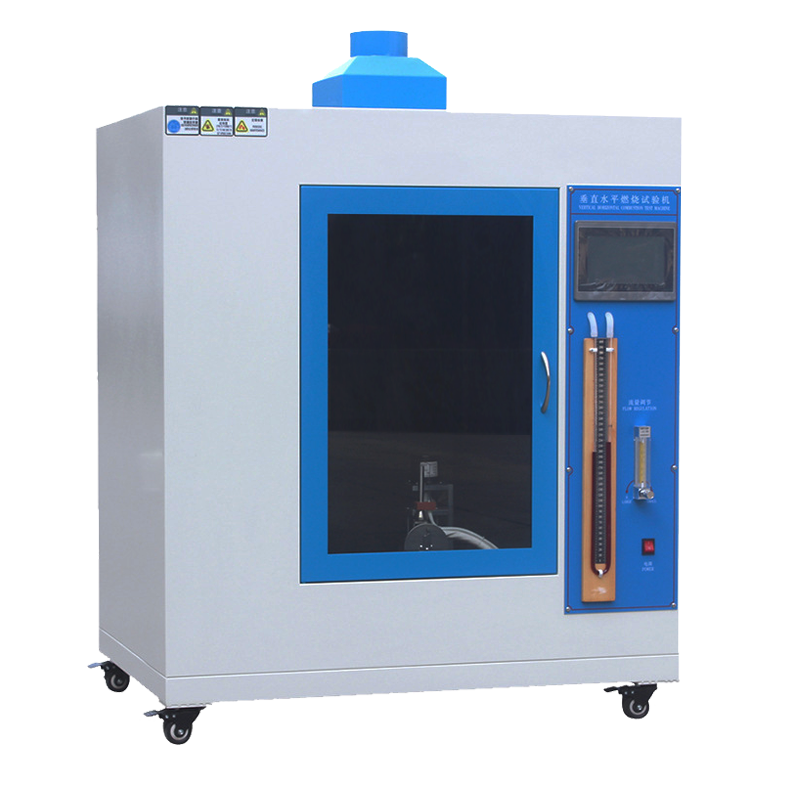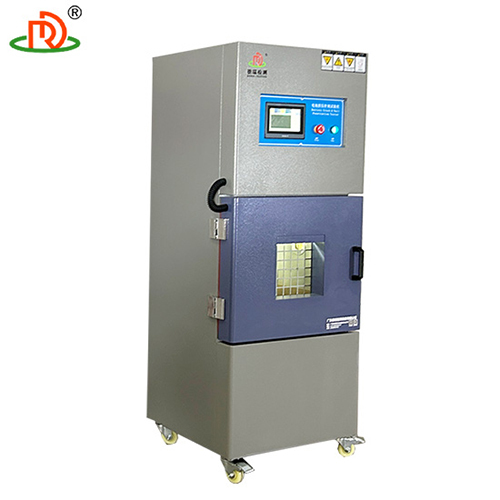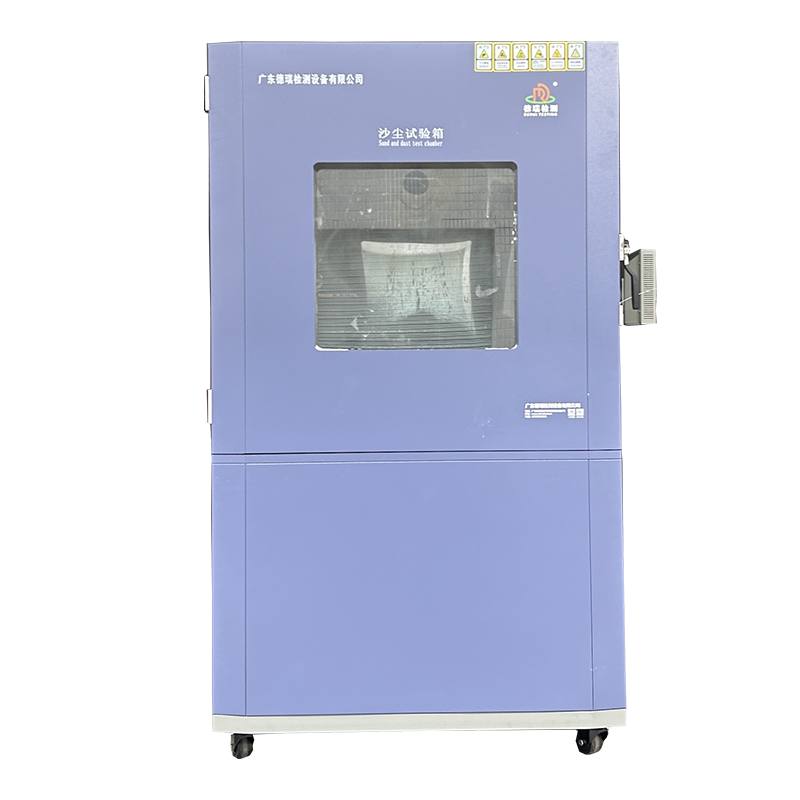
High temperature battery short-circuit testing machine
338005.0 INR/Number
Product Details:
X
High temperature battery short-circuit testing machine Price And Quantity
- 338005.0 INR/Number
- 1 Number
High temperature battery short-circuit testing machine Trade Information
- Cash in Advance (CID)
- 100 Number Per Month
- 5 Days
- All India
Product Description
| Model | DR-D201 |
| Inner box size | 500x500x500mm (width x depth x height); |
| Equipment dimensions | 700x800x1530mm (width x depth x height); |
| Internal material | SUS201 stainless steel plate, thickness 1.2mm, with Teflon affixed; |
| External material | 1.5mm thick cold-rolled steel plate with paint treatment; |
| Observation window | The size is 250x250mm two-layer tempered glass, the transparent window is equipped with stainless steel mesh; |
| Smoke outlet | 100mm in diameter, located at the back of the box; |
| Pressure relief port | The size of the opening is 200x200mm, located on the back side of the box. When the sample explodes, the pressure relief port will pop open to relieve the pressure; |
| Box door | The single door opens to the left, the box door is equipped with a safety limit switch, and the side is equipped with an explosion-proof chain. The device can be operated only when the box door is closed to ensure the safety of personnel; |
| Test hole | There are 2 test holes with a diameter of 50mm on the left side of the device, which are convenient for putting in the collection lines of temperature, voltage, current, etc.; |
| Lighting device | It is convenient to observe the state of the tested sample; |
| Temperature collection range | RT-1000; |
| Temperature acquisition channel | 1 channel; |
| Temperature display accuracy | 0.5; |
| Voltage acquisition range | 0-100V; |
| Voltage acquisition channel | 1 channel; |
| Voltage display accuracy | 0.5%; |
| Maximum short-circuit current | 1000A; |
| Current acquisition channel | 1 channel; |
| Current display accuracy | 0.5%; |
| The internal resistance of the device loop | 8020m; |
| Equipment movement | There are four universal casters at the bottom of the equipment, which can be moved freely; |
| Control method | PLC touch screen control; |
| Equipment weight | 85Kg |
| Power supply | AC220V;50Hz/60Hz |
Equipment features
High-temperature environment simulation: able to accurately control the temperature of the test environment, simulating short-circuit situations under various high-temperature conditions.
High-precision control: Adopting advanced control system, it can accurately control the short-circuit triggering and environmental conditions to ensure the accuracy and reliability of the test results.
Safety and Reliability: Equipped with multiple safety protection devices, such as explosion-proof box, fire extinguishing system and emergency stop device to ensure the safety of the testing process.
Versatility: Suitable for various types of batteries, including lithium-ion batteries, nickel-metal hydride batteries, lead-acid batteries, etc.
Data processing and analysis: Built-in data processing software can automatically generate standard-compliant test reports and provide data analysis functions to facilitate strict quality assessment by quality control personnel.
User-friendly interface: the operation interface is intuitive and easy to use, with simple parameter setting and convenient operation.
Application Fields
High temperature battery short circuit tester is widely used in the following fields:
Battery manufacturing industry: used to evaluate the safety performance of lithium-ion batteries and other types of batteries under high-temperature short-circuit conditions to ensure their safety and reliability in actual use.
Automotive industry: to test the safety performance of batteries for electric and hybrid vehicles in high-temperature environments and ensure their stability under various extreme conditions.
Electronics industry: Evaluate the safety performance of batteries for portable electronic devices in high-temperature environments to ensure their safety during transportation and use.
Quality control: To carry out quality control during the production process to ensure that the battery products comply with relevant standards and customer requirements.
Hot spot effect is a phenomenon triggered by high local temperature during the charging and discharging process of the battery, which may lead to the decline of battery performance, shorten the life, and even cause safety accidents. Temperature-controlled short-circuit test chamber in the prevention of hot spot effect has taken a variety of strategies, the following is a detailed analysis:
1. Precise temperature control
- Uniform heating/cooling: The test chamber adopts uniform heating and cooling technology to ensure uniform temperature on the surface of the battery to avoid localized overheating.
- High-precision sensors: Equipped with high-precision temperature sensors, real-time monitoring of the battery surface and internal temperature changes, to ensure that the temperature is controlled within the set range.
2. Current monitoring and control
- Real-time current monitoring: Through real-time monitoring of the battery current during charging and discharging, abnormal current fluctuations can be found in time to prevent localized overheating.
- Overcurrent protection: set up an overcurrent protection device to automatically cut off the power supply when the current exceeds the safety threshold, preventing the occurrence of hot spot effect.
3. Battery layout optimization
- Reasonable layout: Reasonable arrangement of batteries in the test chamber to ensure sufficient space for heat dissipation between batteries to prevent heat accumulation.
- Heat dissipation material: Use efficient heat dissipation material to improve the heat dissipation efficiency of the battery and reduce the risk of hot spot effect.
4. Test program design
- Gradient test: Design the gradient test program, gradually increase the charging and discharging current and temperature, observe the thermal response of the battery under different conditions, and discover the potential risks in time.
- Cyclic test: Conduct multiple cyclic tests to simulate the long-term performance of the battery in actual use and assess the long-term impact of hot spot effect.
5. Data Analysis and Feedback
- Real-time data recording: Record the temperature, current and other data during the testing process to facilitate subsequent analysis.
- Intelligent Early Warning System: Utilizing data analysis technology, establish an intelligent early warning system to issue timely warnings when the potential risk of hot spot effect is detected.
6. Explosion-proof and safety design
- Explosion-proof structure: The test chamber adopts explosion-proof structure design, which can effectively prevent the explosion from reaching the outside even if the hot spot effect triggers the battery explosion.
- Safety protection devices: Equipped with a variety of safety protection devices, such as fire extinguishing devices, exhaust devices, etc., to ensure the safety of the testing process.
Tell us about your requirement

Price:
Quantity
Select Unit
- 50
- 100
- 200
- 250
- 500
- 1000+
Additional detail
Mobile number
Email








 English
English Spanish
Spanish French
French German
German Italian
Italian Chinese (Simplified)
Chinese (Simplified) Japanese
Japanese Korean
Korean Arabic
Arabic Portuguese
Portuguese